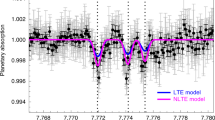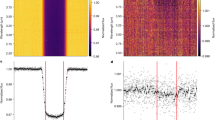Abstract
ALTHOUGH several transitions of formaldehyde have been observed in interstellar space1–7, there has been only one prior report of an observation of the 312–313 transition3. An energy level diagram of the lower rotational levels indicating the transitions that have been detected is given in Fig. 1. The ΔJ=1 transitions are seen in emission. The ΔJ=0 transitions are seen in absorption and emission7–9 with a trend for the higher J transitions to be seen in emission (additional confirmation of this is provided by the unpublished work of B. Turner who has seen the 413–414 transition in emission). Here we report emission from the 312–313 transition at 28.975 GHz in Sagittarius A (Sgr A).
This is a preview of subscription content, access via your institution
Access options
Subscribe to this journal
Receive 51 print issues and online access
$199.00 per year
only $3.90 per issue
Buy this article
- Purchase on Springer Link
- Instant access to full article PDF
Prices may be subject to local taxes which are calculated during checkout
Similar content being viewed by others
References
Snyder, L. E., Buhl, D., Zuckerman, B., and Palmer, P., Phys. Rev. Lett., 22, 679 (1969).
Evans II, N. J., Cheung, A. C., and Sloanaker, R. M., Astrophys. J. Lett., 159, L9 (1970).
Welch, W. J., Bull. Am. astr. Soc., 2, 355 (1970).
Kutner, M., Thaddeus, P., Jefferts, K. B., Penzias, A. A., and Wilson, R. W., Astrophys. J. Lett., 164, L49 (1971).
Thaddeus, P., Wilson, R. W., Kutner, M., Penzias, A. A., and Jefferts, K. B., Astrophys. J. Lett., 168, L59 (1971).
Morimoto, M., Proc. IAU Symp. No. 60 (Reidel, 1974).
Phillips, T. G., Jefferts, K. B., and Wannier, P. G., Astrophys. Lett., 15, 17 (1973).
Kutner, M., and Thaddeus, P., Astrophys. J. Lett., 168, L67 (1971).
Buhl, D., Proc. IEEE, 61, 1198 (1973).
Scoville, N. Z., Solomon, P. M., and Thaddeus, P., Astrophys. J., 172, 335 (1972).
Cheung, A. C., Rank, D. M., Townes, C. H., Thornton, D. C., and Welch, W. J., Phys. Rev. Lett., 21, 1701 (1968).
Buhl, D., and Snyder, L. E., Nature, 228, 267 (1970).
Penzias, A. A., Jefferts, K. B., and Wilson, R. W., Astrophys. J., 165, 229 (1971).
Ball, J. A., Gottlieb, C. Z., Lilley, A. E., and Radford, H. E., Astrophys. J. Lett., 162, L203 (1970).
Venugopal, V. R., and Shuter, W. L. H., Mem. R. astr. Soc., 74, 1 (1970).
Kerr, F. J., and Vallak, R., Aust. J. Phys., Astrophys. Suppl. No. 3 (1967).
Gottlieb, C. A., and Ball, J. A., Astrophys. J. Lett., 184, L59 (1973).
Author information
Authors and Affiliations
Rights and permissions
About this article
Cite this article
MCCUTCHEON, W., SHUTER, W. Observation of the 312–313 transition of interstellar formaldehyde. Nature 251, 123–124 (1974). https://doi.org/10.1038/251123a0
Received:
Issue Date:
DOI: https://doi.org/10.1038/251123a0
Comments
By submitting a comment you agree to abide by our Terms and Community Guidelines. If you find something abusive or that does not comply with our terms or guidelines please flag it as inappropriate.



